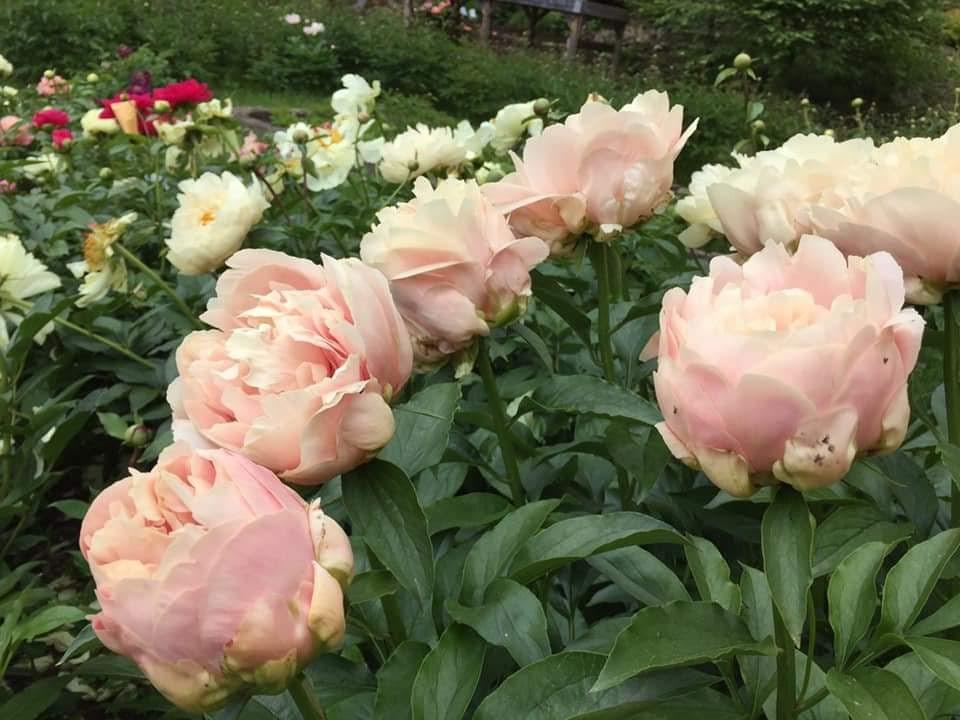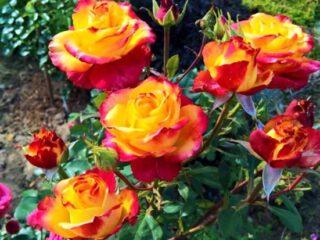Content
Peony Pastelorama is almost never found in Russia and the CIS. It is cultivated in the West, where it was developed. This rare hybrid does not cause problems in cultivation and easily gets used to changing soil when transplanting. Meanwhile, peony stands out for its decorative properties, which is why it is used in the design of gardens and parks.
Breeding history
Pastelorama was developed by American botanist Roger Anderson. The scientist worked to create a universal variety that could take root in unfavorable conditions. This is how the Pastelorama peony appeared in 2013.
Description of peony Pastelorama with photo
The culture is a small herbaceous bush. The maximum height is 85 cm. The leaves are medium in size, up to 10 cm in length.
From the outside, the Pastelorama peony resembles an artificial flower - all because of the unusual palette of buds. The latter have wide petals, neatly folded with each other.

Together the petals form a fairly large flower with a diameter of 20 cm
In the center of the bud are the stamens.They are barely noticeable due to the dense arrangement of the petals. In summer, the Pastelorama peony exudes a pleasant scent. It is almost imperceptible to the human nose. Pollinators, as well as ants, respond to this aroma.
Mature plants have strong stems necessary to support the flower mass. Green leaves are in harmony with them in color. They are smooth and small.
Timing and flowering period
Two years after planting, the variety forms its first flowers. The duration is short, only about two weeks. At the end of spring, buds appear at the top of the bush. There are quite a lot of them, since the variety is early flowering.
The petals fall off on their own, and after budding, fruits with seeds appear in their place. They do not have good germination, so there is no need to worry about uncontrolled colonization of the garden.
Advantages and disadvantages
Pastelorama peonies make lush bouquets. Sometimes they are brought to Moscow and St. Petersburg, the flowers last for about 10 days.

The plant can be planted even in clay and sandy substrates if you have time to prepare them shortly before planting
Pros:
- unusual palette;
- large diameter of buds;
- compactness of green mass;
- frost resistance.
Minuses:
- rarity;
- burning of petals in summer.
When and how to plant
To plant Pastelorama peonies, you will need an area of medium light. In this way, the gardener minimizes one of the disadvantages associated with the burning of flowers. Planting in the shade is also unfavorable, since the crop will not be able to feed normally - because of this, the buds will grow small and, probably, will not open at all.
You will need neutral soil. An acidic environment, such as a peat bog, inhibits the root system of the Pastelorama peony, which soon affects the development of the flower mass.
In the homeland of the variety, planting procedures are carried out in March. In Russia, due to the later onset of summer, work is carried out in April or May. Autumn planting is also encouraged. If you place seedlings in September, they will undergo stratification and take root faster, and they will develop strong immunity.
A month before planting, it is necessary to dig up the area, weed it and apply fertilizer. If the land is fertile, the latter is not necessary. When the soil has settled, that is, after about four weeks, a 70 x 70 cm hole is dug in the same place for the Pastelorama peony. The depth should be at least 80 cm. A space of 100 cm is left between the holes.

If the substrate is dry, water it thoroughly before rooting.
To improve the drainage ability of the soil, sand is used. It is poured onto the bottom in one or several layers. Then they add garden soil, previously diluted with organic fertilizer, and plant the Pastelorama peony.
Care Tips
Pastelorama is a hybrid peony that does not require constant supervision. As gardeners say, it can be planted and forgotten before flowering. However, some procedures should not be neglected:
- Loosening. Loosening improves soil permeability. At the same time, weeds are weeded, which prevent the rapid growth of peonies.
- Watering. Pastelorama is watered weekly - once.In summer, as in the hottest season, frequent watering is allowed. You can add prophylactic medications along with water. For example, a solution of potassium permanganate will prevent the appearance of most pests and pathogens.
- Garter. To prevent branches from cracking and the crown to maintain its original appearance, a garter is necessary. To do this you will need a stick and nylon thread.
Peony Pastelorama needs to be fed with special mixtures. Seedlings planted in fertile substrate do not require this. However, after two years it is mandatory to use fertilizers:
- April - urea;
- May – mullein solution;
- during and after budding - superphosphate.
Wintering
The frost-resistant variety Pastelorama does not need protection. It is enough to organize a layer of mulch (10-12 cm) around the peony.

Plants up to two years old are covered with spunbond
Reproduction methods
Peony Pastelorama can be propagated:
- stem cuttings;
- seeds;
- division.
The seeds are usually used by experienced gardeners - and then only for the purpose of obtaining new varieties of peonies. Cuttings bloom in the fifth year, and divisions in 2-3 years.
Disease and pest control
The main pest is the ant, which is attracted by the smell of a flowering plant. The insect is repelled by planting fragrant crops next to the Pastelorama peony. It could be mint or oregano.
Diseases that can harm the variety are mainly of the fungal type. To eliminate them, fungicidal preparations are used. If the Pastelorama peonies are attacked by the mosaic virus, they must be urgently removed from the site. Otherwise, the disease will spread.
How it is used in landscape design

Bushes are grown near paths to be able to enjoy flowering

The plant looks good in a group with other peonies.
Conclusion
Peony Pastelorama is a fragrant and extremely rare variety, which in Russia is usually grown by collectors. It is unpretentious, rarely gets sick, and can be cut for a long time.
Reviews from flower growers about the Pastelorama peony








